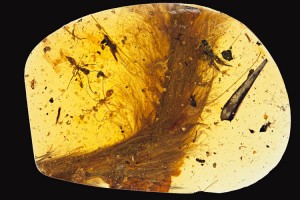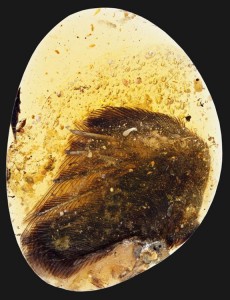A Dino Tail in Amber
Tuesday, December 27th, 2016December 27, 2016
Lida Xing, a paleontologist (scientist who studies fossils) from the China University of Geosciences in Beijing, made a spectacular find just by going to the market. There, he found part of a tiny dinosaur—complete with feathers—perfectly preserved in amber.

A lump of amber has preserved this feathered dinosaur tail (along with ants, a beetle, and bits of foliage) for 99 million years. Credit: © Ryan C. McKellar, Royal Saskatchewan Museum
Amber is a hard, yellowish-brown fossilized resin. It comes chiefly from the resins of pine trees that grew millions of years ago. These resins were gummy materials mixed with oils in the trees. When the oils oxidized (combined with oxygen), hard resins were left. These pine trees were then buried underground or underwater, and the resins slowly changed into lumps of amber. These lumps often contain insects trapped as the resins flowed from the trees. But finding larger animals such as small vertebrates (animals with backbones) is incredibly rare.
Xing found the remarkable fossil at an amber market in the Southeast Asian nation of Myanmar (also called Burma). The seller thought the bushy object in the amber was part of a plant and had polished the piece to be made into jewelry. But it was in fact part of the feathery tail of a small dinosaur. Xing promptly brought the specimen to fellow paleontologist Ryan McKellar of the Royal Saskatchewan Museum in Regina, Canada, where they studied it with other scientists using computed tomography (CT). Computed tomography involves taking many X-ray images of an object from a number of directions. A computer combines the set of X-ray “slices” of the object to create a three-dimensional image called a volumetric model. The scientists recently wrote about what they found in the journal Current Biology.
Paleontologists have discovered feathered dinosaur fossils in the past, but the heavy weight of the sediments and rocks deposited above them had flattened the carcasses during the fossilization process. Because this tail was trapped in amber, however, it was preserved in three dimensions, allowing scientists to see the exact layout of the feathers. Even traces of the pigments that colored the feathers have been preserved, showing that the animal would have been light brown with a whitish underside.
The tail likely belonged to a juvenile (young) bipedal dinosaur related to Tyrannosaurus rex. Despite the specimen’s prominent plumage, paleontologists know that the tail belonged to a nonbird dinosaur (all birds are technically dinosaurs). The fossil dates back 99 million years, some 50 million years after the appearance of early birds such as Archaeopteryx. A tail from Archaeopteryx would have been short and stiff. The tail from this new fossil, however, is long and flexible. It is bent a great deal in the amber, and scientists estimate that only a third of the tail was preserved. Furthermore, the beautifully preserved feathers trapped in amber would have been useless for flight. The feathers possess simple barbs and barbules that would hold strands of the feathers together, but they have much thinner central shafts than modern flight-worthy feathers. These ancient feathers would have been soft and downy, and they probably kept the young animal warm.
The loss of the dinosaur’s tail in amber probably cost it its life. Dinosaurs could not detach their tails the way some lizards can. A dinosaur could likely survive without the tip of its tail, but this fossil is from the mid-section of a dinosaur’s tail. Once the hapless youngster got stuck in resin, it probably either starved to death or became an easy snack for a predator—except for the part stuck in resin, of course.
Lida Xing has a knack for making spectacular finds of amber-entrapped animals. Earlier this year, he announced the discovery of a pair of 100-million-year-old bird wings. His remarkable discoveries are shining a new light on the evolution of feathers in birds and dinosaurs.



